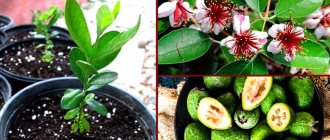Home » Garden and vegetable garden » Vegetable garden » Vegetables
Vladimir 03/20/2020
5897 Views
Like most fruit-bearing nightshade crops, physalis came to us from the Western Hemisphere. It is there that the greatest diversity of species of this plant is observed. In nature, this plant is quite unpretentious; In warm and temperate climates, physalis grows as a perennial. Many people grow and care for physalis at home, since its fruits have remarkable properties: from medicinal to culinary.
Description
Ripening fruits of Physalis ornamentalis
In fact, the genus Physalis is the largest genus of the Solanaceae family, since it includes more than one hundred and fifty species, however, almost all of them grow in Brazil, Mexico and Peru. In the climate of Europe, there are only three types of physalis: common or ornamental physalis, vegetable physalis and strawberry physalis. The fruits of the first are poisonous due to the high concentration of corned beef in them; the remaining two can be used as food, having properties similar to tomatoes.
That is, physalis is actually a small cold-resistant tomato. In many languages of the world it is called “Mexican tomato”.
Physalis vegetable fruits
Due to the characteristic shape of the capsules of ripening fruits, physalis are called “Chinese lanterns” and are very often used not as food, but as ornamental plants. The sight of ripe physalis fruits located in the center of veined capsules always attracts attention.
Ripe physalis fruit without outer integumentary tissue
The branches of Physalis vegetable bushes are capable of rising to a considerable height and completely entwining fairly large areas on which nets or trellises are installed.
Fruit collection
Harvesting, as a rule, is possible 2 months after planting physalis on the site. By this time they are already ripe. This should only be done in dry weather. Those that have fallen to the ground are also suitable for use as food or processing. It is only necessary to inspect and discard fruits that are clearly rotten.
Preparing physalis for wintering
- The stems of vegetable and berry crops, like all tomatoes, are disposed of after harvesting, and the soil is dug up.
- Decorative physalis remains in the ground for the winter, but is completely cut off to ground level. Bouquets are formed from branches with fruits, which are used to decorate the home.
Biological description
Being a representative of the Solanaceae family, physalis has adopted many of the properties characteristic of it. In particular, the plant does not have a very strong stem, which does not allow it to grow straight and support several kilograms of fruits, however, if there are possible supports, the plant is able to grow upward, entwining them. If there are no supports, the length of the stems rarely exceeds 60-70 cm.
The leaves of the plant are quite large, up to 12 cm long and 6 cm wide, the flowers are mostly white, consisting of 5 petals. A characteristic feature of the physalis flower is the transformation of the calyx of the flower into the outer shell of the fruit , the same one that looks like a Chinese lantern. Its size can significantly exceed the size of the fruit itself and even be larger than a chicken egg.
Physalis blooms
One short stem can contain up to two dozen fruits, and even more fruits can be found on stems artificially tied or attached to supports. The size of the fruit depends on the variety and ranges from 5 to 7 cm. The yield of physalis can reach up to 5 kg per plant.
Let's consider the types of physalis presented in our climate:
Physalis vulgaris
Other names for this species: garden or wild. The original form of the plant, brought from South America. Traditionally considered a wild form due to the inedible fruits and their small size. However, it is believed that in fact, in our climate, it simply does not have time to fully form its fruits, since it lacks light and heat.
On the other hand, of all the physalis species growing in our latitudes, this one is the most cold-resistant, and in the southern regions it is actually a perennial. In many places, the plant is not even cultivated, but grows like a weed, multiplying and spreading by self-seeding.
Physalis wild with a large number of fruits, grown in natural conditions
This species is mainly used to compose various floral compositions, since its fruits have the most attractive and extravagant appearance compared to other varieties.
Strawberry physalis
Another name for the plant is strawberry tomato or dwarf gooseberry. A low-growing plant with small-sized fruits. Belongs to the Peruvian group of varieties that appeared relatively recently.
Strawberry physalis
It is the most heat-loving species of all present in our climate, but, despite the fact that its fruits are more tasty than those of the vegetable physalis , it is not particularly widespread.
Vegetable physalis
A less cold-resistant species than the ordinary one, but capable of withstanding light frosts. In our area it is an annual. It is considered a cultivated species, the fruits of which are used by humans.
Belongs to the Mexican group of physalis, representatives of which were domesticated several thousand years ago. Due to sufficient cold resistance, it is planted in the ground several weeks earlier than tomatoes.
It is more resistant to diseases and pests of nightshades. Shows good resistance even to such a “killer of nightshades” as late blight.
This species is cross-pollinated, which makes it possible to engage in its selection, although there is practically no significant and fundamental work in this direction. Similar to the common one, by autumn the boxes of its fruits become bright orange or red.
The fruits themselves have a slightly different shade - they are mostly pale yellow, although there are exceptions. The main difference between ordinary physalis and vegetable physalis is the much larger size of the latter’s fruits.
Purple form of vegetable physalis
It is the vegetable physalis that can grow on stretch marks and supports up to 2 meters in height. It all depends on how to care for the plant. However, even without any care, the plant can reach a height of 1 meter.
The Mexican tomato, which is most widespread in Europe, has several dozen varieties, the most common of which are:
Early Moscow variety
It is a plant with a higher degree of branching, with predominantly recumbent stems. The foliage has an elongated oval shape, its color is light green. The flowers are distinguished by the presence of brown spots on a white and yellow background. The calyx covers the fruit almost completely.
The fruits are usually round in shape, their diameter is 40-50 mm, and their weight is about 60 g . Unripe fruits are green, turning yellow as they ripen; Sometimes ripe fruits have a yellow-amber hue.
Fruits of the Moscow early variety
The fruits of this variety have a sweet taste . The sour taste characteristic of many other varieties of vegetable physalis is practically absent. Ripens relatively early - in early or mid-summer. Productivity can reach 5 kg per square meter. m.
Variety Gribovsky ground
Despite the name, it is a relatively tall plant, growing up to 80 cm in height without supports . The leaves are dark green in color and oval in shape. The leaves are smooth to the touch. The flowers have an uncharacteristic green color and are covered with light brown spots.
The capsule containing the fruit covers it entirely. The veins are dark green, sometimes brown. The fruits themselves, even when ripe, are green. The weight of the fruit can reach 60 g.
Fruits of the Gribovsky soil variety
The fruits have a sweet and sour taste . It is a cold-resistant variety and can be stored for a long time. Productivity from 3 to 5 kg per square meter. m.
Confectionery grade
Created relatively recently, specifically for the needs of the confectionery industry. It is a plant with branching and spreading stems. The leaves have a dark green color. Flowers, fruits and boxes are light green. Fruit weight 50-60 g.
Confectionery grade
The taste is sweet and sour, the fruits can be stored for a long time. It is characterized by a high content of jelly-like substances.
RELATED MATERIALS
4,25
2
Seeds of large-fruited strawberry hybrids are expensive. In addition, the package contains from 3 to 10...
4,57
34
Petunia attracts with its variety of varieties, hybrids and ease of cultivation. If you bought...
5
It takes 2 years from sowing lavender seeds to flowering. We did it for you! Watch the full master...
5
Master class on growing seedlings of mallow, or pink hollyhock.
4,43
2
Traditional advice is to sow peppers on April 10–15, 60 days before planting two-month-old seedlings in the garden...
Tomato seedlings must be strong and healthy - then after planting in the ground they will turn into...
5
1
When you don’t want to mess around with the soil in the fall, when you want to do everything simply and quickly, but you...
5
1
Why do you need a rack for seedlings? Is it possible to do without it? How to do it yourself? Answers to …
5
If you sow seedlings in winter, then you cannot do without a phytolamp. You will need it like seeds...
Growing a plant
In our climate, vegetable physalis is grown using seeds. They have good germination even at temperatures from +10°C. The plant is very unpretentious and requires virtually no care.
It is believed that when planted directly into the ground, the yield is slightly higher than with the seedling growing method . This is explained primarily by the fact that plants planted in this way do not lose parts of the root system when picking and replanting. The only advantage of the seedling method of cultivation is the earlier harvest time.
Physalis in the garden
On the other hand, with proper organization of seedlings and using separate containers (for example, peat pots), such troubles with the root system can be avoided. However, few people will bother with physalis seedlings, planting each plant individually.
Let's consider growing a plant when planting in open ground:
Selecting a site and preparing it for sowing
Physalis prefers sunny areas where there is no stagnant water. The level of soil acidity is, in principle, not important for him. But still, it is not recommended to grow the plant on very acidic soils (pH less than 4.5). Such soils must be limed.
Any crop except nightshade can be a predecessor of physalis. It is not advisable to grow physalis in a place where potatoes, tomatoes, eggplants or peppers were grown. It is also not recommended to grow physalis in the same place where it grew last year. Re-sowing after all of the above crops is possible only in the 4th year.
Growing physalis in greenhouse conditions
The soil should be sufficiently fertile and well ventilated. Therefore, in the fall, the site must be dug up to a depth of about 30 cm, having previously fertilized it with rotted manure or compost. The application rates of these organic fertilizers should be approximately 30-40 kg per 1 square meter. m.
In the spring, before digging up the site again, mineral fertilizers are applied to it. It is necessary to apply fertilizers containing phosphorus and calcium in an amount of 15 m 40 g per 1 sq. m. m respectively. The area is dug up again to the same depth as in the fall 2-3 weeks before planting seeds or transplanting seedlings.
Preparing seeds for planting
Large and full-bodied seeds are selected for planting , since they can produce a higher yield. To select seeds suitable for planting, they are immersed in a 5% salt solution and stirred thoroughly.
After about 5 minutes, seeds that do not have the required mass float to the surface. They are thrown away, and the remaining ones are washed with running water and used for planting.
Physalis seeds
Seeds are planted in open ground by mid-April. By this time, you need to prepare the seeds so that they germinate faster. To do this, they are soaked in warm water and kept at a temperature not lower than +20°C for a week. After this treatment, the seeds germinate approximately three days after planting.
Immediately before planting, the seeds are treated in a 1% solution of potassium permanganate in order to disinfect them from fungal diseases and viral infections. Physalis is vulnerable to the tobacco mosaic virus, so after washing it in potassium permanganate, it must also be washed in a 20% solution of hydrochloric acid.
Planting is carried out in the ground to a depth of about 1-2 cm. The seeds are planted in small holes at a distance of 30-50 cm from each other. Several seeds are placed in each hole. You should not thicken the plantings excessively, as the plants will begin to stretch out greatly. Sometimes sand or seeds of other plants, such as radishes, are added to the holes for more uniform sowing.
The latter also act as a beacon crop - since in the cold season, physalis may not germinate quickly, the hatching radish sprouts will indicate exactly the planting location and will act as an indicator of the first work to loosen the soil.
When the physalis sprouts emerge from the ground and grow sufficiently, they are thinned out so that the number of plants per 1 sq. m did not exceed 4 pieces . Usually, the strongest and largest plants, or those with the maximum number of leaves, are left.
Growing physalis seedlings
Seedlings can be grown both indoors and in special greenhouses; Sometimes they practice growing them in greenhouses on beds, covering them with film. When planting, the soil mixture can be of any composition; it is best to choose the one that is used when planting tomato seedlings.
Physalis seeds are sown to a depth of about 1 cm. The distance between seedlings should be 5-6 cm. After planting, watering is carried out. The required temperature for normal germination of seedlings is about +15-17°C.
Seedlings a week after planting
As soon as the plant has two leaves, the seedlings are picked and transferred to individual pots. 1 or 2 plants are transplanted into each pot. It is necessary to water the seedlings abundantly before this operation.
The picking itself is done using pointed stakes about 10 cm long and 1-2 cm in diameter. They need to make a hole in the substrate in the pot and carefully transfer the seedlings there with a small lump of earth, without damaging or filling the growth cone.
Seedlings after picking
After which the plants are placed in the same greenhouse. Caring for seedlings at this stage is the most difficult operation , as it requires concentration and regularity of action. The plant itself is unpretentious, but its seedlings will have to be carefully looked after.
By the time of planting in open ground, the seedlings should already have the first buds , and they themselves should have at least 5-6 leaves. This corresponds to approximately 40-45 days after planting.
Seedlings can grow at temperatures of about 10-12°C, however , it will be better if they are accustomed to this temperature gradually, using the hardening method. Maintaining a temperature of about 15-17°C in the greenhouse, every day during watering it is necessary to open the greenhouse for ventilation, accustoming the plant to the ambient temperature. After about a month, the seedlings can be safely left outdoors, however, in case of cold weather, they must be covered again.
Seedlings need fertilizing every 15 days . The first fertilizing is done on the 10th day after planting and consists of adding ammonium nitrate (watering the plants with a solution of nitrate 20 g per 10 liters of water). It can be replaced by fertilizing with organic fertilizer, which is mullein or bird droppings. Fertilizers are diluted in water at a concentration of 1 to 10 or 1 to 15, respectively. A volume of 10 liters of such fertilizer is enough to water seedlings with an area of about 2.5-3 square meters. m.
The second feeding is carried out using potassium mineral fertilizers . In this case, 10 g of ammonium nitrate and 15 g of potassium chloride must be diluted in 10 liters of water. Seedlings should be watered with this solution at the rate of 10 liters per 2 square meters. m.
The third feeding of seedlings is carried out using superphosphate . For 10 liters of water, 30-40 g of superphosphate is taken, and the consumption rates in this case are already 10 liters per 1 sq. m. That is, in each subsequent feeding, the concentration of fertilizers increases approximately twice as compared to the previous one.
Physalis seedlings a week before planting
After the third feeding, the amount of liquid during watering is reduced by approximately half and remains so until the seedlings are planted in open ground.
Planting seedlings in open ground
Typically, seedlings are planted at the end of May, about 1-2 weeks earlier than tomato seedlings. Immediately in the morning before planting, the seedlings are watered abundantly. It is necessary to mark in advance the area where the planting will take place.
The distances between plants should not be less than 30 cm , in addition, it is advisable to place them on 1 square meter. m no more than four plants of Physalis vegetable. For strawberry physalis, this figure is 6 plants.
Too dense planting
Between the physalis plants, you can plant some other early-ripening crops, for example, lettuce or radishes . This will help to use the sown area more efficiently, and the plants will not interfere with each other, since the harvest of auxiliary crops occurs much earlier than for physalis.
The landing itself takes place in the afternoon, but if the weather is cloudy, the start of the landing does not depend on the time of day. The first watering after planting is carried out not directly under the root of the plant , but at some distance from it, so that an earthen crust does not form around the bushes.
If the soils are poorly drained or there is a high groundwater level, it is necessary to use beds 30-40 cm high for growing physalis, since the plant has a very negative attitude towards excess moisture at its roots.
Preparing seeds for sowing
Physalis seeds must be sorted before sowing. To do this, place them in a 5% solution of table salt for 10 minutes. High-quality seeds will settle to the bottom, and the dummies will float to the surface. For sowing we will use the seeds located at the bottom of the container.
After sorting, it is recommended to disinfect the seeds - this is an excellent disease prevention. First, the seeds are heated in a thermos with hot water (+50 degrees) for 2 hours. After this, the heated seeds are dipped in a slightly pink solution of potassium permanganate for half an hour. After finishing disinfection, wash in warm water.
After disinfection, the seeds are germinated - wrapped in a damp cloth and then placed in a container with a lid. Transfer the container with the seeds to a warm place. Regularly moisten the material so that the seeds do not dry out. The first seeds usually germinate on the 5th day.
Ungerminated seeds should not be planted. They either will not sprout or they will grow into weak, sickly plants.
Plant care
As such, physalis does not require active care. Basically, when growing it, they take preventive measures, which include maintaining the plant and the area in normal shape, removing weeds, loosening the soil, applying fertilizing and watering.
The frequency of watering under normal conditions is once every 3-4 days. Depending on the degree of soil moisture and precipitation, this period may be adjusted. There is no need to keep the soil wet all the time. Repeated watering is carried out provided that the top layer of soil is completely dry.
Physalis on the terrace
Nightshades generally do not like excessive humidity, so it is better to even “dry” the physalis a little.
During the active growth of the green part of the plant, it is necessary to regularly loosen the soil, ridding it of weeds . Depending on the growth rate of the plant, it is necessary to fertilize it. Usually, the first fertilizing after digging up the soil in spring is done during the first flowering. The second is during fruit set. The third feeding is carried out 15-20 days after the second.
In these cases, solutions of complex mineral fertilizers are used in quantities of 10 to 20 g per 1 square meter. m.
You can make the mixture yourself using the following composition of mineral fertilizers:
- ammonium nitrate – 10 g
- superphosphate – 10 g
- potassium salt – 15 g
All these components are dissolved in 10 liters of water and applied to the soil at the rate of 10 liters per 1 sq. m. Just in case, to neutralize superphosphate when mixing it with ammonium nitrate, you can add about 1-2 g of chalk to the solution.
It is believed that physalis does not require garters or pinching , since this, they say, does not allow the formation of strong and persistent stems. However, this is not an immutable rule or dogma, since in growing any crop in the garden, what is important is not its appearance, but its yield.
Harvest
Physalis fruits begin to be collected from mid-July at intervals of 4-7 days. Thanks to the protective shell in the form of a kind of flashlight, the fruits, after falling to the ground, retain all their commercial qualities for a long time without spoiling. Physalis continues to bush and set fruit until October and can even withstand temperatures down to -2 C.
To speed up the filling and ripening of already formed physalis fruits, with the approach of cold weather, all flowers and the uppermost shoots are plucked out. Just before the first frost, all the berries are harvested and ripened at home. And unripe fruits can be stored in the refrigerator until spring. Physalis is considered a relatively productive crop. One square meter of such planting yields half a bucket of delicious berries per season, and each bush brings about 2-3 kg of harvest.
Physalis berry fruits are good fresh due to their sweetness and aroma. But, nevertheless, the fruits reveal their flavor spectrum only after some kind of culinary processing. There are a myriad of recipes and culinary tricks that turn physalis into a delicious delicacy. Perhaps this is the only crop from which an equal variety of both sweet and savory dishes are made. Berry physalis can be used immediately for its intended purpose, but vegetable physalis requires preliminary preparation in the form of blanching with boiling water for 2-3 minutes. This procedure removes the sticky film and possible bitter taste.
Canned physalis salad
Ingredients:
- Physalis – 1kg
- Cucumbers – 1kg
- Carrots – 500g
- Onion – 500g
- Garlic – 300g
- Black pepper - 10 peas
- Sugar – 100g
- Salt - 40g
- Vinegar - 100g.
Blanch the physalis, cut the carrots, onions, garlic and cucumbers into slices. Mix all the vegetables together, add salt, sugar, pepper and leave for 10-15 minutes until the juice is released from the vegetables. After this, put on fire and boil for 10 minutes with vinegar. Place in sterile jars and roll up.
We shouldn’t focus only on growing popular vegetable crops familiar to us from childhood, when there is such a tasty and exotic variety as physalis that can grow in our beds. I am sure that in the garden of every summer resident there is a place for this unusual plant, and shelves with winter preparations with its participation will be able to please and delight even the most demanding gourmet, especially in winter.
Blog for summer residents – GreenMarket
Recommendations for protecting physalis from diseases and pests
Physalis, compared to tomatoes or peppers, is much less susceptible to any negative factors in the form of diseases or pests. However, the ease of caring for it may form the wrong opinion that even preventive measures to protect it should not be taken.
Hanging pot with physalis
Naturally, this is not so. To prevent the spread of diseases and prevent the plant from being attacked by pests, it is necessary to follow a number of measures and apply specialized methods to prevent these factors.
The following measures will help you get rid of possible troubles when growing physalis:
- Procurement of seed material should be carried out exclusively from your own plot, only from healthy plants that have been tested for productivity; It is better to avoid cross-pollination with other areas;
- seeds must be treated before sowing;
- it is imperative to adhere to crop rotation , correctly observe the alternation of successors and predecessors, and in no case allow nightshades to grow in the same place without a break of at least three years;
- it is necessary to constantly combat weeds and any pests;
- it is necessary to regularly remove plant debris from the growing area, since they can become a place for the same mold or other fungi to appear;
Using these simple tips will greatly protect physalis from possible problems in the form of diseases.
Properties of Physalis
The plant has many beneficial properties that people have noticed for quite a long time.
It all started, naturally, with the nutritional and culinary benefits of physalis. However, it later turned out that this plant also has other beneficial properties, mainly medicinal.
Culinary properties
Physalis is a low-calorie product, it contains only 30 kilocalories per 100 g of weight. Despite its relatively watery composition, physalis is rich in fiber and carbohydrates. The taste of physalis fruits is practically indistinguishable from tomatoes, but they have some features, for which they are valued by gourmets.
Physalis can be consumed both dry and processed . Its fruits are used in many different dishes, and not only analogues of those that include its closest brother, the tomato. These include soups, side dishes, and sauces. Physalis is also used as a filling for pies. And dried physalis is a very significant export item for countries such as Colombia and Mexico.
Dessert with physalis
In addition to the standard procedures of frying, stewing, baking and other things characteristic of tomatoes, various confectionery products are also made from physalis in cooking : preserves, jams, candied fruits. This is explained by the fact that of all the nightshades, only physalis has gelling properties.
Making physalis jam
That is, in fact, the decorative Chinese lantern in cooking is even more common than the long-known tomato . We are not talking about our cuisine, however, this plant is very popular in South and Central America.
In addition, dried and specially processed physalis tastes and looks very much like raisins . This dried physalis is often used as a weight loss remedy. Red and orange food dyes are also made from physalis.
Medical properties
The plant also contains vitamins A and C, as well as many organic compounds necessary for humans.
These include malic and citric acids, carotenoids and tannins. Physalis also contains the following microelements: potassium (one of the highest concentrations), magnesium, phosphorus, iron.
All this leads to many ways to use physalis in medicine, both folk and traditional. In particular, thanks to the lycopene it contains, which is a powerful antioxidant, the use of physalis in food is recommended for the prevention of cancer.
Physaline, contained in the fruits of the Mexican tomato, is an excellent sleeping pill; in Mexico there is a known recipe for obtaining a sleepy drug from physalis, which has virtually no negative consequences.
Dried physalis used in folk medicine
In addition, the medicinal uses of the plant include its use as a hemostatic, analgesic and antiseptic. , where physalis naturally arrived relatively recently, its decoction is used as a remedy to help with stomatitis and various injuries inside the oral cavity. And the pectin contained in fruits is able to bind cholesterol, facilitating the release of the latter from the body.
Types and varieties
Physalis edible is divided into physalis berry and physalis vegetable. The physalis berry is represented by such species as raisin physalis, or pubescent physalis, or strawberry physalis, Peruvian physalis, which has recently begun to be grown in the middle zone, and Florida physalis, as well as their varieties.
Physalis floridana
It has sweet, pleasant-tasting fruits without any fruity aftertaste and almost no acidity. The jam made from this type of berries resembles cherry jam, so when cooking, leaves of fragrant geranium are added to it.
Physalis pubescens
It has a more refined taste - sweet, with barely perceptible sourness and a pronounced taste and smell of pineapple. The juice of the fruit resembles tangerine juice. The fruits of this physalis can be stored for up to 3-4 months, or even up to six months, acquiring a slightly withered appearance over time. Dried fruits really resemble raisins.
Physalis peruviana
It is not as sweet as raisins, but the fruity taste and aroma of its fruits is stronger, and in terms of the amount of acids and sugar they contain, they are close to garden strawberries. Physalis berries of this species are too tender for long-term storage.
The best varieties of physalis berries include:
Mexican physalis (Physalis ixocarpa), or glutenous
Physalis vegetable is represented by the species Physalis Mexicana, or glutenous, and its varieties. The fruits of the vegetable physalis resemble tomatoes more than the fruits of other species. Among vegetable physalises, there are tall varieties, and there are also low, spreading ones. The fruits are yellow, green, and purple in color, and they vary in shape and size. Vegetable physalis are less demanding of heat and more productive, but when fresh they are not as tasty as berry ones. But they make excellent marinades, pickles, caviar and salads. The most famous varieties in the culture of the middle zone:
Physalis decorative
Chinese lanterns - represents species of herbaceous perennials. All its parts are not only inedible, but also poisonous, but it enjoys constant success among landscape designers. This physalis reaches its greatest decorative value in late summer or early autumn, when its boxes acquire a bright orange color.
Popular varieties:











